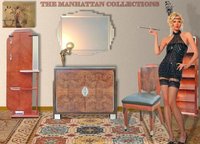Catégories FURNITURE Art déco furniture The Art Deco style
The Art Deco style

The Art Deco style
Art Deco style at started in the early 1900s, culminating at the beginning of the period Art Deco 1920. To retrace the development or the emergence of Art Deco, should begin in Paris of 1925 World's Fair. The International Exposition of modern industrial and Decorative Arts is at the origin of this controversy, new style, announcing the coming of the modern, industrialized world. 'Period' Art Deco is generally regarded as objects produced from around 1925 until 1939 when the second world war, plagued Europe and later the United States the stylistic Art Deco influences continued after the war, as evidenced in many ways in the design of the 1950s and what we now call mid-century modern. Art Deco has a substantial impact in most all areas including the design of jewellery, sculptures, furniture art deco, glass, Tiffany lamps, architecture and graphic design. The artists of the period such as Demetre CHIPARUS were influenced by Egyptian, Greek, Roman, and the far East themes and historical objects. Art Deco also coupled these classical influences with modernism, as evidenced by the design of automobiles and trains, and these industrial expressions of Art Deco have made their way into consumer as well.
The period from 1920 until the beginning of the 1930s was marked by many contrasts, from the times of the "Roaring 20s" nature by the Great Depression and its aftermath. Art Deco elegant style offered people the sophistication to Cool, the creation of new objects environments, man made materials like bakelite plastic and using exotic woods and inlays in furniture. New and faster trains and ships made accessible distant lands, and Hollywood and the explosion of the radio has these adventures and of course entertainment for the general public. Simple, geometric lines are inherent in the Art Deco style; objects were simpler than the Art Nouveau but have been streamlined and elegant in their angular shapes and vibrant colors. Today, our period of buildings like the Chrysler Building in New York with its ornamental gargoyles and money that recalls the arrow of the giant rays of Sun - a popular Art Deco theme - preserving the Art Deco style. The Empire State Building was built immediately after the depression, and the project was one of the only major construction projects still ongoing in these difficult times. The pink and blue neon Miami Beach hotels still remind us of the elegant simplicity of its design characteristics of Art Deco. Industrial design has prospered during the period Art Deco, and a fascinating variety of consumer products have been produced in all the Art Deco style integration simplified price ranges. Even holders of transport such as trains and automobiles became aerodynamic. In fact, many of the most famous designs of the 20th century have been designed in the deco style - Rockefeller Center, the Golden Gate Bridge, cinemas, gas, bus, dinners, the SS Normandie stations stations, bus Greyhound, Air-King radios, Electrolux and the vacuum cleaner. The designers of furniture Art Deco and sometimes with fully covered their parts in exotic materials, such as mother of Pearl, grey, Snakeskin, gold and silver leaves, shells of eggs crushed lacquer and ivory. These materials generally form a geometric pattern or a certain type of model as the flowers. Well known Art Deco designers include Donald Deskey, Russel Wright, Norman Bel Geddes, Paul T. Frankel, and Emile-Jacques Ruhlman.
The man-made materials have been incorporated into the design as industrial plastic (Bakelite, Lucite), chromium, and aluminum. The use of plastic also made possible the production of consumer goods such as radios inexpensively in large quantities, and the shapes and colors previously unattainable. Bakelite radios that time as Spartan and Fada are collected, but at the time of their production they brought colorful design and the sound of the radio to the public through industrialization and mass production techniques. Manufacturers such as Chase and Farberware helped streamline forms, even in the world of cocktail shakers, best illustrated by the famous zeppelin design and other interpretations of skyscrapers, etc. Art Deco interior design and furnishing also used as materials chromium and other metals, glass and plastics in new and innovative ways and styles. Art Deco furniture give a sense of elegance and style in interior decoration, design and constant streamlines various furniture coexist harmoniously in a room to create a modern look. Graphic arts were also strongly influenced by Art Deco and streamline its way into advertising posters Travel boat or train travel and even Coca-Cola bottle designed by Raymond Loewy. You can clearly see the influence of Cubism launched by Picasso and Braque in the Art Deco graphic arts, that reality is distorted by condensing the design of simple lines and angular shapes.













 00 33 9 62 52 65 54
00 33 9 62 52 65 54 infos.services@royaldecorations.fr
infos.services@royaldecorations.fr